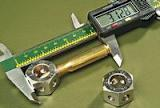How much variation is typical when seating bullets?
I am using 2 Hornady Custom dies with micrometer top and 1 Redding Competition Seater die (also micrometer), all in a Hornady Lock-N-Load Classic press. If I set a seating depth and just load 10 or 25 rounds and only check them with the comparator afterward, then I find variations of 1-3 thousandths plus or minus. (More variation when seating compressed loads, less when there's ample space.) I have found those variations with 4 different .243/6mm bullets and at least 3 different .308 bullets. To deal with the variability, I often back the micrometer off by ~2 thousandths before first seating each bullet, then measure BTO and dial 1 to 4 thou more as needed to seat within a half-thousandth of my intended BTO.
So, how much variation is typical when seating a bunch of rounds without measuring every time a round leaves the die?
I never see more than .001" --- If that
Any variance of +/- .001" is usually only from slight variances/resistance of neck tension
If you look at the profile of the Ogive, the seating stem must contact at the right point of the ogive
---The further down the Ogive the better
If your stem is seating by pushing more against the tip of the bullet this could be why you are seeing variation
Or worse
If the tip is actually making contact which could throw things off as much as .010"
so between the start of the ogive curve, and the tip, the closer to the tip of the bullet your stem makes contact, then the more seat depth variance you will experience.
There are VLD stems you can buy
Or you could drill out the stem to a larger hole dia. (with a lathe so it is concentric)
I think a good dia. hole for your stem would be whatever the hole dia is on your Comparator for that caliber.
You may need to drill your seating stem deeper to make sure the bullet tip has enough clearance to not make contact inside the seating stem. Especially those long sleek VLD's
----------------
You may also lap the hole of the stem with the exact bullet you use most
You ideally want a decent amount of bearing surface when making contact to distribute the force over the bullet, as opposed to making contact with just a ring, which will indent the bullet and deform it
Deforming the bullet by pushing it in on itself will also give variance
-------------------------
I use one of these
The holes in the Hex Comparator are cut with throating reamers
to accurately duplicate the actual throat of a rifle
---I've never felt that complicating something simple, offers better results












